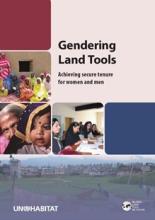Land Library Search
Through our robust search engine, you can search for any item of the over 73,000 highly curated resources in the Land Library.
If you would like to find an overview of what is possible, feel free to peruse the Search Guide.
/ library resources
Showing items 1 through 9 of 13.This publication, from the Global Land Tool Network, presents a mechanism for effective inclusion of women and men in land tool development and outlines methodologies and strategies for systematically developing land tools that are responsive to both women and men’s needs.
The paper elucidates the current structure of university education in Belarus and particularly emphasises available levels of education.
Developing new land policies can be a long and difficult process. It is even more so if the policies are to be pro-poor – if they are to help correct the disadvantages that poor people typically suffer in many areas of land policy.
This guide presents a general overview on institutional harmonisation processes, i.e. the various factors and tools included in fostering institutional harmonisation in a sector.
This publication on Secure Land Rights for All demonstrates how secure land rights are particularly important in helping to reverse three types of phenomena: gender discrimination; social exclusion of vulnerable groups; and wider social and economic inequalities linked to inequitable and insecure
In the face of trends towards a widening “food gap” and general poverty, this paper attempts to address the problem by discussing the methodologies necessary for sustainable land management to ensure improved food security, rapid economic development and poverty reduction in developing countries
The main objective of the Country Environmental Analysis (CEA) in Nepal is to identify opportunities for enhancing the overall performance of select environmental management systems through improvements in the effectiveness of institutions, policies, and processes.
Con ocasión del Año Internacional de las Montañas (2002), la Organización de las Naciones Unidas para la Agricultura y la Alimentación (FAO) y sus asociados emprendieron una sistematización mundial en gran escala de la situación actual y futuras tendencias de la gestión integrada y participativa








